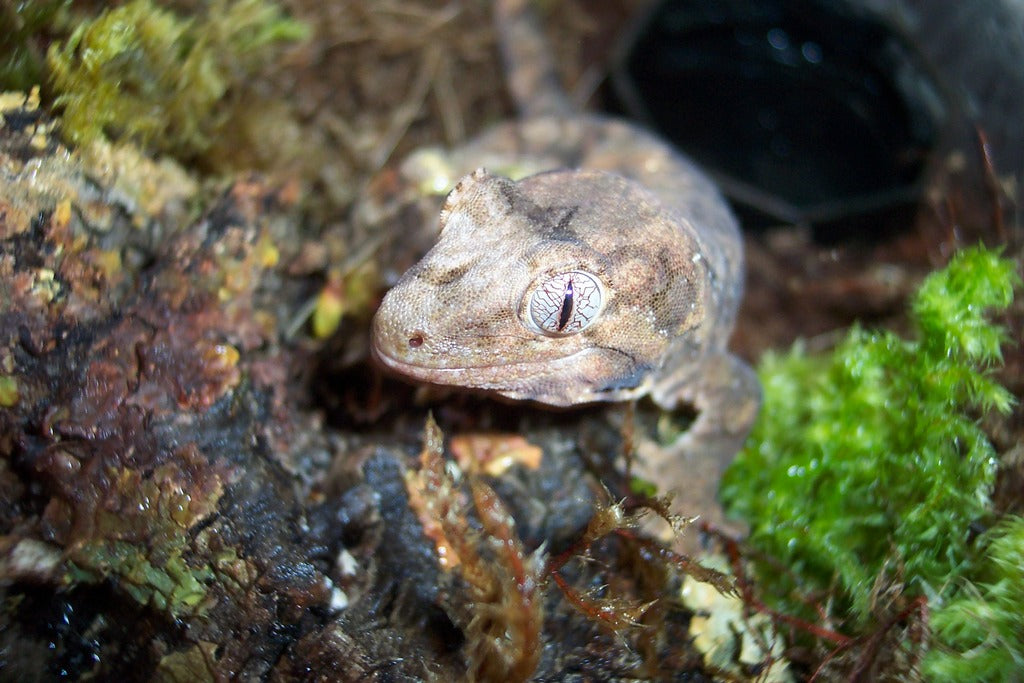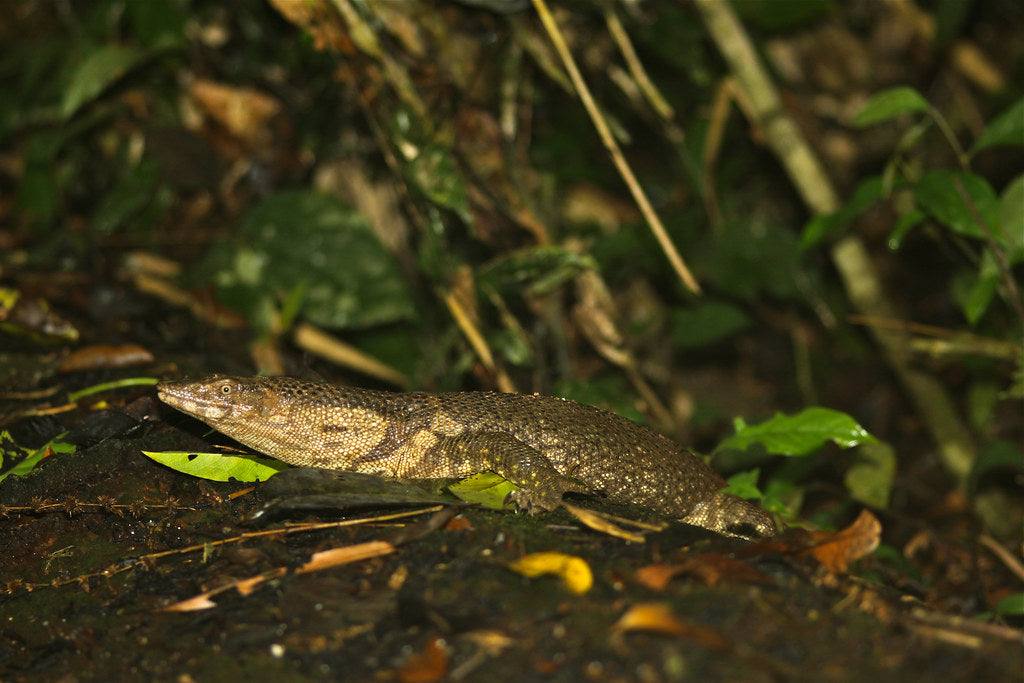Chinese cave geckos (Goniurosaurus sp.) are a group of 5.5-9.5” long, terrestrial, nocturnal lizards native to parts of China, Vietnam, and Japan. Their preferred habitat is lowland rainforest near rock formations and/or caves with high humidity and dense foliage cover.
Chinese cave geckos vary in appearance depending on the species in question. Some are dark with thin yellow bands, some are green-gold with dark mottling and/or speckles, and others are essentially patternless. However, as a general rule, they have a black and white banded tail, bumpy skin, primarily gold and brown-black coloring, and orange-red eyes with vertical pupils. Although they are geckos, they have eyelids and do not have sticky toe pads. However, their claws still make them skilled climbers.
Chinese cave geckos are secretive reptiles that like cool temperatures and high humidity levels, making them intermediate-level pet reptiles. With good care, they live an average of 10-12 years.
Chinese cave geckos’ care requirements are generally fairly similar from species to species, however there are essential differences that should be noted. This care sheet should be used only as a general guide, and we strongly recommend doing research on your specific species of cave gecko for best results.
How much space do Chinese cave geckos need?
A single Chinese cave gecko should be housed in no smaller than a 30”L x 12”W x 12”H enclosure. Of course, larger is always better!
Cohabitation (keeping multiple Chinese cave geckos in the same terrarium) is possible, but not required. They can be housed in small groups of multiple females, or one male and multiple females if you wish to breed. You will need to at least double the minimum recommended enclosure size to prevent unnecessary conflicts between geckos.
Do Chinese cave geckos need UVB?
They can survive without it as long as they receive supplementary vitamin D3, but it’s still recommended. UVB gives them all of the vitamin D that their bodies need, stimulates better appetite and activity, and generally allows them to be healthier than they would be without.
The best UVB bulbs for Chinese cave geckos are:
- Zoo Med T8 ReptiSun 5.0
- Arcadia ShadeDweller Kit
The UVB bulb should be roughly 1/3 to 1/2 the length of the enclosure and housed in a reflective Arcadia or Vivarium Electronics fixture. Place the lamp close to the heat lamp, about 8-10” above the basking surface. UVB is blocked by glass and plastic, so you can’t give your pet UVB by placing its terrarium in front of an open window. Also make sure that the fixture your UVB bulb is in does not have a clear plastic bulb cover. UVB bulbs decay over time, so you will need to replace your bulb every 6-12 months (according to manufacturer instructions) to maintain performance.
Lights should be on for 13.5 hours/day during summer and 10.5 hours/day during winter to replicate seasonal cycles and encourage healthy hormonal rhythms.
What basking temperatures do Chinese cave geckos need?
Despite being “room temperature reptiles” at first glance, Chinese cave geckos DO benefit from having access to a basking area. After all, they’re still ectotherms, which means that they need a temperature gradient in their enclosure to help them regulate their metabolism and stay healthy.
Chinese cave geckos should have a low basking temperature between 80-82°F, as measured by a digital probe thermometer with the probe placed on the basking surface. The cool zone on the other side of the enclosure should stay between 72-75°F. Heat lamps should be turned off at night. Nighttime temperatures can drop as low as 68°F.
Provide heat for your gecko with a low-wattage heat lamp placed on one side of the enclosure. Do not use red bulbs, or blue bulbs, as these are not as effective. Lightless heat sources such as CHEs and DHPs can be used if night temps get too cold.
What humidity levels do Chinese cave geckos need?
Chinese cave geckos are a tropical species, so they need fairly high humidity levels in their enclosure: 70-80% on average, with nightly spikes up to 100%.
Misting your gecko’s enclosure with a sprayer first thing in the morning and again at night will help create the right humidity levels. If you have difficulty maintaining high humidity levels, running a reptile humidifier at night can help. Make sure your gecko has access to a humid hiding place at all times.
What substrate is good for Chinese cave geckos?
You will need at least 2” of substrate to help maintain healthy humidity levels. More substrate will be required if you want to use live plants as part of the setup.
We recommend the following substrates for Chinese cave geckos:
Layering clean, chemical-free leaf litter on top of the substrate can also help with humidity and enhances the enclosure’s appearance.
Substrate should be completely replaced every 3-4 months. Remove poop and urates daily, along with any contaminated substrate.
What décor can you use in a Chinese cave gecko terrarium?
It’s terribly boring for a reptile to be stuck in an enclosure with nothing in it except substrate and food/water bowls. It doesn’t matter how big the enclosure is if you don’t put things in it for your pet to use and interact with! Chinese cave geckos tend to appreciate a fairly densely planted enclosure with plenty of climbing material, which can make their terrarium a great piece of home décor!
Here are some ways you can decorate/enrich your gecko’s environment:
- cork tubes
- cork flats
- branches
- ledges
- live or artificial plants
- additional hides
What do Chinese cave geckos eat?
Chinese cave geckos are primarily insectivorous, which means that they need to eat insects (preferably live) in order to get the nutrition that their bodies need. Juveniles should be fed daily, and adults should be fed 3-5x/week depending on body condition. Feeding sessions should last about 5-10 minutes. Each insect should be slightly smaller than the gecko’s head.
Feeder insects for Chinese cave geckos: dubia roaches, discoid roaches, crickets, black soldier fly larvae, small hornworms, mealworms, mealworm beetles
Supplements
You will need calcium and vitamin supplements to help prevent your Chinese cave gecko from developing a deficiency. We recommend Repashy Calcium Plus LoD, lightly dusted on all of your lizard’s feeder insects at every other feeding.
Water
Provide a medium-sized, shallow water bowl where your lizard can always get a drink. Change the water daily and scrub the bowl with a reptile-safe disinfectant weekly, or whenever it becomes soiled.
Do Chinese cave geckos like to be handled?
Few reptiles actually “like” to be held, and Chinese cave geckos are not one of them. These are a “look but don’t touch” kind of pet. Attempting to handle is very likely to cause excessive stress, which is bad for their health. Instead of interacting with your lizard by holding it, try hand-feeding it instead with a pair of soft-tipped feeding tweezers.
*This care sheet contains only very basic information. Although it’s a good introduction, please do further research with high-quality sources to obtain additional information on caring for this species.
"File:Goniurosaurus orientalis mâle.jpg" by Lisen67 is licensed under CC BY-SA 4.0




Leave a comment
This site is protected by hCaptcha and the hCaptcha Privacy Policy and Terms of Service apply.